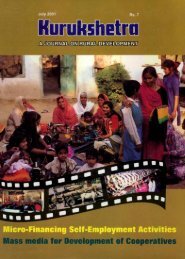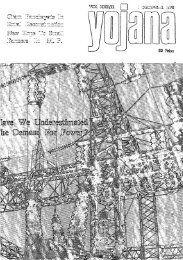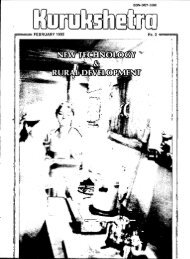Banking - Yojana
Banking - Yojana
Banking - Yojana
- TAGS
- banking
- yojana
- yojana.gov.in
Create successful ePaper yourself
Turn your PDF publications into a flip-book with our unique Google optimized e-Paper software.
Generated by PDFKit.NET Evaluation<br />
Narasimham Committee has<br />
recommended that given the<br />
special needs of this sector, the<br />
current practice may continue.<br />
However, for ensuring greater<br />
involvement and accountability<br />
and also appraisal of schemes on<br />
commercial considerations<br />
without any extraneous influences,<br />
the branch managers of banks<br />
should be fully responsible for the<br />
identification of beneficiaries<br />
under the government sponsored<br />
• credit linked schemes. However,<br />
this recommendation is yet to be<br />
acted upon. Generally,<br />
beneficiaries in such schemes are<br />
political persons or persons<br />
favoured by poli tical parties.<br />
Implementation of this<br />
recommendation means direct<br />
attack on political interest.<br />
There is no doubt that the first<br />
phase of financial reform yielded<br />
fruitful results. The second phase<br />
of the process also got started with<br />
the implementation of some ofthe<br />
recommendations of the s~cond<br />
Narrasimham Committee in the<br />
1998 monetary and credit policy,<br />
announced by the Reserve Bank of<br />
India, Governor Dr BimalJalan.<br />
Let us start with the issue of<br />
capital adequacy ratio. In his first<br />
report Mr Narasimham proposed<br />
that the capital base of a bank can<br />
be increased in two ways. First by<br />
building a fund with the recovered<br />
bad loans of the banking sector as<br />
• a whole. This fund will be termed<br />
Asset Reconstruction Fund (ARF)<br />
and capitalwillbe infused from this<br />
fund for recapitalization of weak<br />
banks with low capital adequacy<br />
ratio. In the second method<br />
recapitalisation will be made by<br />
using massivebudgetary funds. The<br />
committeewasin favouroffallowing<br />
the first route, because the second<br />
one is not only costly but is<br />
unsustainable over time.<br />
. YOJANAJuly2002<br />
Click here to unlock PDFKit.NET<br />
Unfortunately the government, in<br />
the lastcouple ofyears,followedthe<br />
second route in order to get quick<br />
and immediate result.For example,<br />
the State Bank of India and the<br />
Oriental Bank of Commerce were<br />
the onlypublicsectorbanksto access<br />
the market and follow the<br />
conventional wayof boosting their<br />
capital, while other nationalised<br />
banks haveboosted their capitalwith<br />
infusion of funds from the<br />
government. However,thispolicy is<br />
against the long-run objective of<br />
reducing fiscal deficit of the<br />
governmen t and is totally<br />
undersirable. In his second report,<br />
Mr Narasimham again<br />
recommended the constitution of<br />
ARF,both to meet the problems of<br />
NPAs and low capital adequacy<br />
rations.<br />
Merger<br />
Coming to the problem of<br />
merger of bank branches in the<br />
line proposed by the second<br />
Narasimham Committee. The<br />
Committee disfavoured the idea of<br />
merger among .strong and weak<br />
units on the argument'that it might<br />
produce adverse impact on the<br />
asset quality of the stronger unit as<br />
a result of acquiring the hollow<br />
portfolio of the weaker unit in the<br />
absence of any systemof written off<br />
the NPAsof the weaker unit before<br />
merger. On the other hand,<br />
according to the committee,<br />
merger of strong units may<br />
produce better multiplier effect.<br />
However, many economists<br />
conveyed their dissen t on this<br />
prescription of the second<br />
committee. They argued that such<br />
merger between stronger banks in<br />
different countries, e.g. in the<br />
U.S.A.,Japan, Singapore, failed to<br />
produce positive result in recent<br />
past. The most important point to<br />
argue is that merger in those<br />
countries were the result of<br />
pressure of competition. Hence<br />
that was inevitable. But here such<br />
merger is going to be imposed on<br />
them. That might have adverse<br />
impact.<br />
Argument is also there against<br />
the method of 'narrow' banking'<br />
prescribed by the second<br />
committee for the recovery ofweak<br />
banks. It is argued that there is<br />
insufficient supply of risklessassets<br />
to back potential demand for<br />
riskless deposits. Moreover,<br />
increased demand for riskless<br />
assets would raise their prices in a<br />
narrow banking world. Some have<br />
also argued that instead of narrow<br />
banking these banks require<br />
aggressive banking. This means<br />
that this banks should not resort<br />
to riskless investment which are<br />
generally lowyielding; instead they<br />
should invest in securities of'first<br />
classcommercial companies which<br />
are risky but high-yielding. With<br />
this aggressive banking they would<br />
be more attentive and give more<br />
effort in recovering bad debts.<br />
It may be said that there may be<br />
arguments and counter arguments<br />
on various issues. But this does not<br />
mean that the reform should be<br />
halted and the debate be solved<br />
first. Rather we have to advance<br />
following trial and error method.<br />
Let us finish with the words of the<br />
second Narasimham Committee<br />
(Narasimham Committee Report<br />
on <strong>Banking</strong> Sector Reform, 1998)<br />
which sounds like: "The process of<br />
strengthening the banking system<br />
has to be viewed as a continuing<br />
one. There is no finite end to<br />
improving the levels of efflciency<br />
and profitability. In fact, the<br />
situation is one where the system<br />
has to cope constantly with<br />
changes in the broader<br />
environment in which it functions<br />
and face new challenges thanhese<br />
developments impose on it." 0<br />
9






